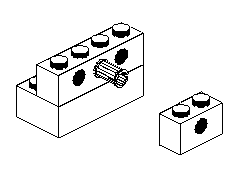|
|
|
|
| Learner Outcome: Students will be able to construct straw rockets and predict how to achieve the longest flight possible. |
| Set up: Pairs of students design and build straw rockets, launch with a preset force, measure distance, record and check. |
| Objective: Students can design, build, and test their own miniature straw rockets. They will conduct experiments by varying the trajectory angle. |
| Materials: Pneumatic LEGO elements for straw rocket launcher (Pitsco-LEGO Education) 1/4 inch diameter straws, 3/16 inch diameter bendy straws, clay, scissors, clear tape, brown tape, paper, graph paper, pencils, protractors, rulers and yard sticks. |


Directions:
| 1. Build the launcher following the picture directions. |
| 2. Cut the straw and stop up the end with clay. |
| 3. Test different lengths, weights, and pick the best. |
| 4. Test 90 degrees and describe horizontal displacement. |
| 5-8. Test and record the distance for two trials of 0, 30, 35, and 60 degrees. Estimate , then measure lengths of distance traveled to the nearest 1/8 inch . |
| 9. Average the distance in pair trails. |
| 10. Collect all classroom data |
| 11. Find the Mean (average) by hand and check by calculator, then calculate and record in inches and centimeter. |
| 12. Have two pairs of students input data in a spread sheet by having one student say and another input data. |
| 13. Calculate means and display data for each trajectory angle. |
| 14. Each student write up their science journals describing building and launching procedure.. |
Evaluation: Students can identify 45 degree launch angle as giving longer flights than 0, 30, 60 or 90 degrees.
Student's addition and division checks with calculator answers.
Students can show the best outcomes on their graphs.
![]()
West Virginia IGO's Covered:
| 5.10 Use estimation to solve problem and determine reasonableness |
| 5.14 Use computation , estimation, calculators nd computers to solve application problems |
| 5.20 Solve problems by using guess and check, make a table, and find a pattern |
| 5.23 Collect, organize and display, read a nd interpret numerical data, tables, graph |
| 5.24 Find the Mean of the given set of data |
| 5.26 Construct and interpret tables to draw reasonable inferences or verify predictions using available technology |
| 5.29 Compare and measure acute angles using protractor |
| 5.36 Estimate and measure lengths of real objects in parts of inch up to 1/8 inch |
| 5.44 Compute and convert customary units of measure within the same system in problem-solving situations. |
| 5.45 Select appropriate tools for measuring to desired degree of precision. |
| 5.50 Use calculator to solve application problems |
| 5.52 Use calculator to find Mean. |
| 5.53 Use a calculator to convert customary units to metric units in problem solving situation |
| 5.54 Use graphing software to organize and display data by creating table and bar graph. |
| 5.55 Practice inputting data using correct keying, editing and formatting techniques. |
![]() .
.
Picture
Gallery
Davis Creek 5/11/99
![]()
Enrichment Activity:
Assign students to research on the Internet
and find another rocket design. Allow
time
to build and display rocket.
Created By:
Linda Hamilton
Laura Leadman
Sharon Simon
5/11/99 Updated 26 March
2005